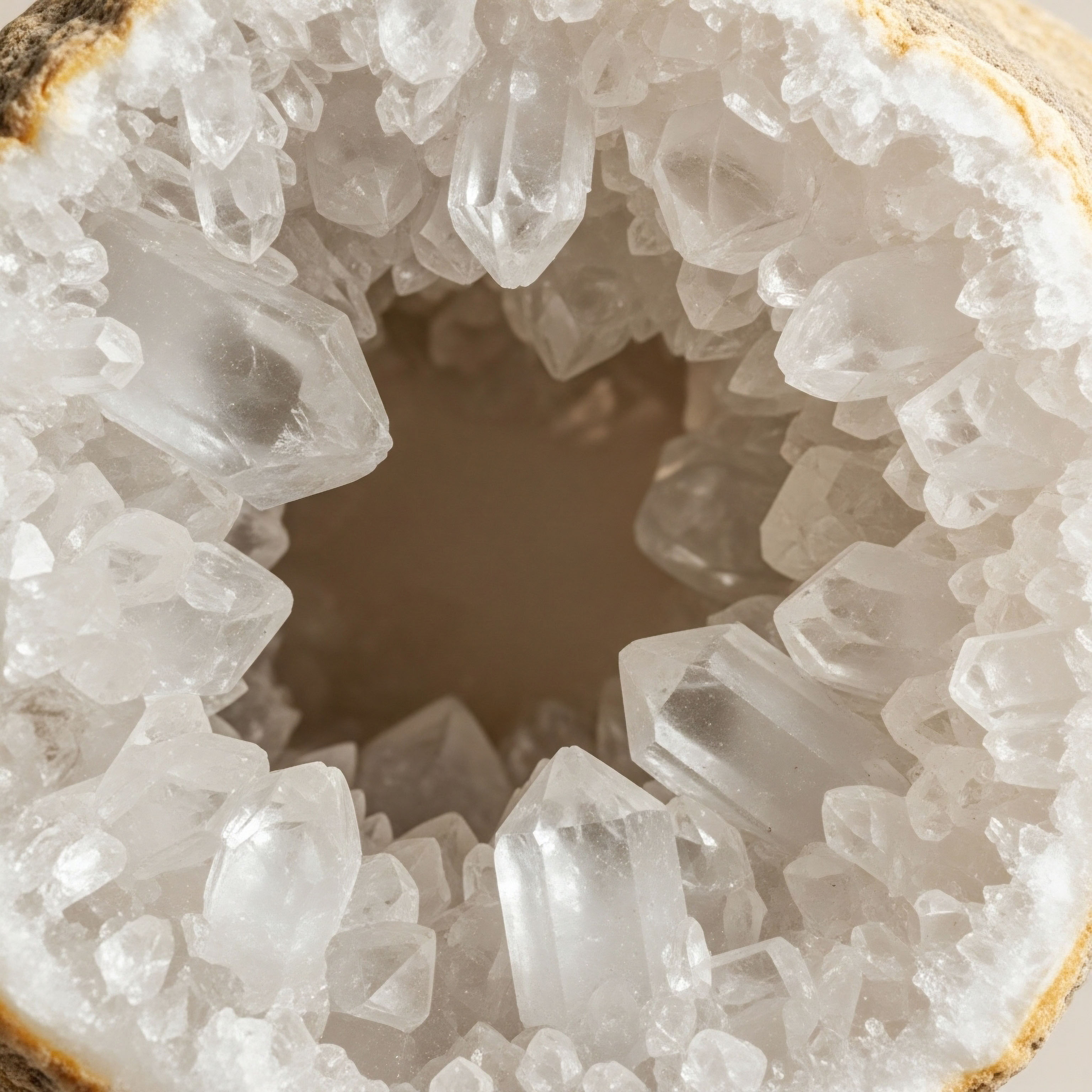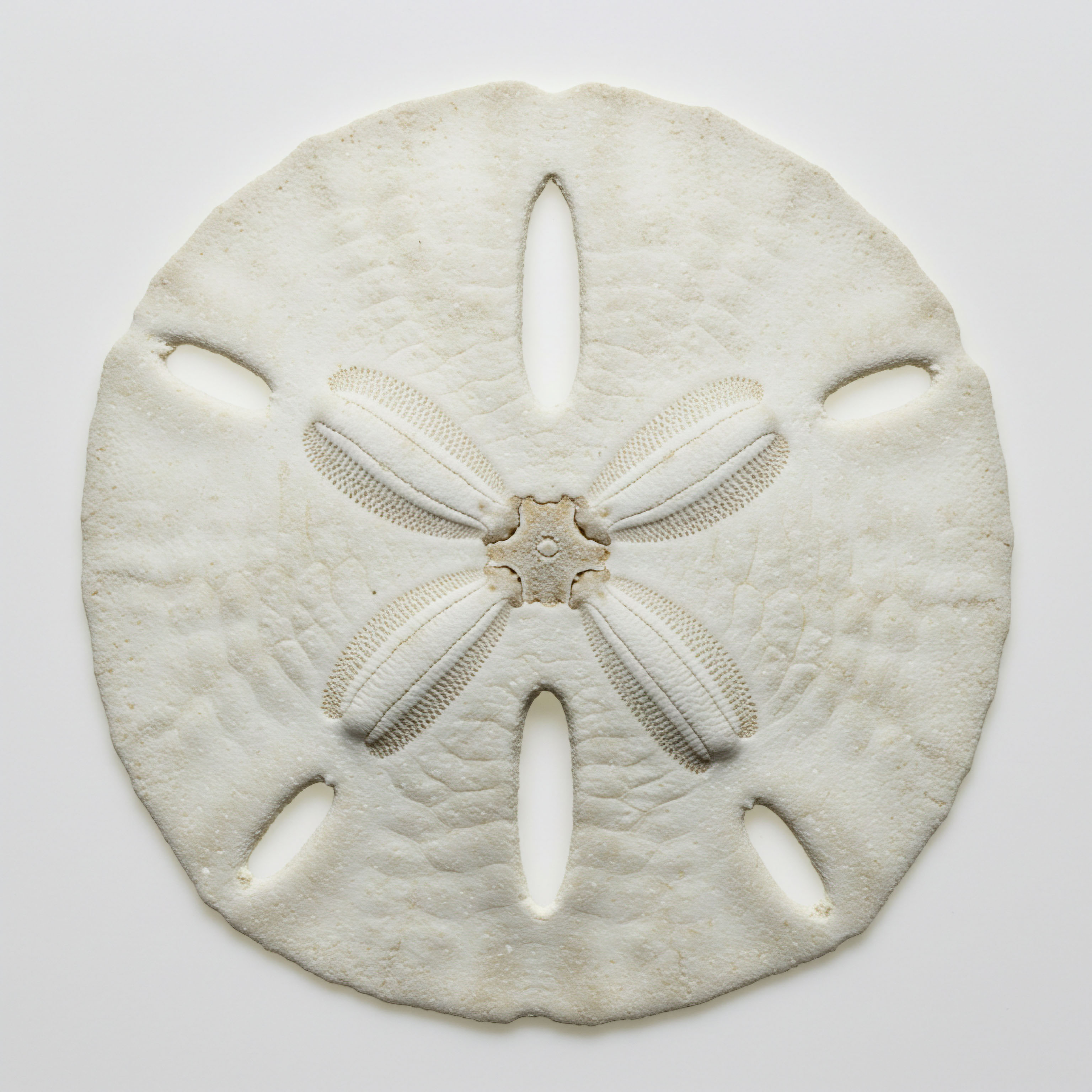

Fundamentals
You have likely noticed the subtle shifts in your skin’s texture and resilience over time. Perhaps a certain suppleness has diminished, or a new fineness to the lines around your eyes has appeared. This lived experience is a direct reflection of profound changes occurring within your body’s intricate communication network.
Your endocrine system, the master regulator of your physiology, uses hormones as its chemical messengers to direct the function of every cell, including those that build, maintain, and repair your skin. Understanding how to maximize the aesthetic benefits of hormonal optimization begins with recognizing that skin health is an expression of systemic, biological vitality. The goal is to restore the very architectural blueprint that gives your skin its youthful structure and function.
The appearance of your skin is intimately tied to the precise balance of three primary hormones ∞ estrogen, progesterone, and testosterone. Each plays a distinct and collaborative role in maintaining the skin’s integrity. Estrogen is the principal driver of dermal health, directly stimulating cells called fibroblasts to produce collagen and elastin.
These proteins form the structural matrix that provides your skin with its firmness and elasticity. Estrogen also promotes the synthesis of hyaluronic acid, a molecule that can hold many times its weight in water, which is responsible for the skin’s plumpness and hydration. When estrogen levels decline, particularly during the transition into menopause, the skin’s ability to produce these essential components wanes, leading to thinning, dryness, and the formation of wrinkles.
Hormonal balance is the foundational support system that dictates the skin’s structural integrity and youthful appearance.
Progesterone and testosterone are equally important contributors to this biological architecture. Progesterone helps to regulate sebum (oil) production, which is crucial for maintaining the skin’s protective barrier and preventing excessive dryness or oiliness. It works in concert with estrogen to ensure proper hydration and skin balance.
Testosterone, while present in smaller quantities in women, is fundamental for maintaining the thickness and strength of the dermal layer. It supports the structural scaffolding that estrogen helps to build. The gradual loss of these hormones creates a cascade effect ∞ the structural supports weaken, hydration diminishes, and the skin’s natural repair processes slow down.
Therefore, a properly calibrated hormonal optimization protocol is designed to replenish these key messengers, effectively instructing your cells to resume the vital functions of repair and regeneration that define healthy, vibrant skin.

The Cellular Basis of Hormonal Influence
To truly appreciate the benefits of hormonal recalibration, it is helpful to visualize your skin at a cellular level. The dermis, the layer beneath the surface, is a dynamic environment teeming with fibroblasts, collagen fibers, and elastin. Think of hormones as the project managers of this environment.
When estrogen docks onto its specific receptors on a fibroblast, it initiates a direct command to increase the production of Type I and Type III collagen, the most abundant forms in youthful skin. This process actively rebuilds the skin’s foundation, making it thicker and more resilient. The result is a visible reduction in fine lines and an improvement in overall firmness.
The decline in these hormonal signals means the project managers have left the site. The fibroblasts become less active, collagen production slows dramatically, and existing collagen begins to break down more rapidly. This is the biological reality behind the visible signs of aging.
By reintroducing these hormones in a physiologically balanced way, we are essentially sending the project managers back to work with a clear set of instructions ∞ rebuild the scaffolding, enhance the hydration systems, and restore the skin’s structural integrity from the inside out. This approach views beauty as an authentic outcome of deep cellular health.


Intermediate
Moving beyond foundational concepts, we can examine the specific clinical strategies used to restore the skin’s biological function. These protocols are designed with precision, aiming to re-establish hormonal concentrations that mimic a youthful physiological state. The objective is to provide the body with the specific molecular signals it needs to rebuild and maintain the skin’s extracellular matrix.
This involves a sophisticated understanding of not just which hormones to use, but how they are delivered and balanced within the body’s complex feedback systems. We are essentially providing the raw materials and the instructions for a complete dermal renovation.

Protocols for Female Hormonal Recalibration
For women, a comprehensive protocol often involves a carefully balanced combination of testosterone, progesterone, and, when appropriate, estrogen. While many associate testosterone exclusively with male physiology, it is a critical component of female health, contributing significantly to skin thickness, muscle tone, and libido.

Testosterone Cypionate for Dermal Integrity
The standard protocol for women often involves weekly subcutaneous injections of Testosterone Cypionate, typically at a low dose of 10 ∞ 20 units (0.1 ∞ 0.2ml). This method provides a steady, consistent level of testosterone, avoiding the peaks and troughs that can occur with other delivery systems. Testosterone directly supports the skin’s structural integrity by maintaining the density of the dermis.
As estrogen levels fall, the supportive role of testosterone becomes even more pronounced. Furthermore, a portion of this testosterone will naturally convert to estrogen in the body’s tissues, providing localized benefits. For some individuals, pellet therapy offers a long-acting alternative, where a small pellet is placed under the skin and releases a steady dose of testosterone over several months.
To ensure the hormonal ratio remains optimal, Anastrozole, an aromatase inhibitor, may be prescribed in small doses. This medication blocks the enzyme that converts testosterone into estrogen, preventing an overabundance of estrogen and allowing for more precise control over the hormonal environment.

The Role of Progesterone in Skin Hydration
Progesterone is another key player, prescribed based on a woman’s menopausal status. It is crucial for balancing the effects of estrogen and has its own distinct benefits for the skin. Progesterone helps regulate the skin’s moisture levels and oil production. Low progesterone can contribute to dryness and flaking, which accentuates the appearance of fine lines.
By maintaining adequate progesterone levels, the skin can better retain moisture, leading to a more supple and hydrated appearance. This biochemical recalibration ensures that all aspects of skin health ∞ structure, hydration, and barrier function ∞ are addressed simultaneously.

Growth Hormone Peptides a New Frontier in Rejuvenation
Beyond direct hormonal replacement, an advanced strategy involves the use of growth hormone peptides. These are not hormones themselves; they are short chains of amino acids that act as powerful signaling molecules, known as secretagogues. They work by stimulating the pituitary gland to produce and release the body’s own natural growth hormone (HGH). This approach is fundamentally different from injecting synthetic HGH, as it honors the body’s natural pulsatile release patterns and feedback mechanisms.
Peptide therapies act as precise biological signals, instructing the body to amplify its own innate repair and regeneration processes.
Peptides like Sermorelin and the combination of Ipamorelin with CJC-1295 are at the forefront of this therapy. They bind to specific receptors in the pituitary, triggering a cascade that results in elevated levels of HGH and, consequently, Insulin-like Growth Factor 1 (IGF-1). This elevated IGF-1 is a primary driver of the anti-aging benefits seen with this therapy. It promotes cellular repair, lean muscle development, and fat metabolism, but its effects on the skin are particularly noteworthy.
The table below outlines some of the key peptides used for rejuvenation and their specific benefits for the skin:
| Peptide Protocol | Primary Mechanism of Action | Key Benefits for Skin Health |
|---|---|---|
| Sermorelin | A GHRH analogue that stimulates the pituitary to produce HGH. | Increases skin firmness, improves moisture retention, and supports overall cellular repair. |
| Ipamorelin / CJC-1295 | A potent combination where CJC-1295 extends the life of the HGH pulse generated by Ipamorelin. | Enhances collagen production, improves skin elasticity, accelerates wound healing, and promotes deeper, more restorative sleep, which is critical for skin repair. |
| Tesamorelin | A highly effective GHRH analogue, FDA-approved for other indications, known for its potent ability to increase IGF-1. | Significantly boosts collagen synthesis, improves skin thickness, and enhances overall skin texture and resilience. |
| MK-677 (Ibutamoren) | An oral ghrelin mimetic that stimulates HGH and IGF-1 secretion. | Improves skin tone and elasticity, helps thicken the dermis, and promotes a more youthful skin appearance over time. |
By using these peptides, we are not just replacing a missing component; we are reactivating a dormant system. We are sending a powerful signal to the body to ramp up its own production of the master repair hormone, leading to systemic benefits that manifest visibly in the quality, texture, and resilience of the skin.


Academic
A sophisticated analysis of hormonal optimization for cutaneous benefit requires an examination of the molecular and systemic biology at play. The aesthetic changes observed are downstream manifestations of complex interactions within the Hypothalamic-Pituitary-Gonadal (HPG) and Growth Hormone (GH) axes.
The efficacy of hormonal therapies lies in their ability to modulate gene expression, protein synthesis, and cellular behavior within the dermal and epidermal layers. This section will explore the specific molecular pathways through which sex steroids and growth hormone secretagogues exert their rejuvenating effects on human skin.

The Molecular Endocrinology of Cutaneous Aging
The skin is a primary target organ for sex hormones, expressing a high density of androgen receptors (AR), estrogen receptors (ERα and ERβ), and progesterone receptors (PR). The decline in circulating levels of 17β-estradiol during menopause is a principal driver of cutaneous aging in women. Estrogen’s effects are mediated through the activation of its receptors, which function as ligand-activated transcription factors.

How Do Hormones Regulate Skin Gene Expression?
Upon binding estrogen, ERs translocate to the nucleus and bind to Estrogen Response Elements (EREs) on the promoter regions of target genes. This action directly upregulates the transcription of genes essential for dermal integrity, including COL1A1 and COL3A1 (encoding Type I and Type III collagen) and hyaluronic acid synthase (HAS2).
Clinical research and meta-analyses confirm these mechanisms. A systematic review published in the journal Skin Rejuvenation in Women using Menopausal Hormone Therapy demonstrated that menopausal hormone therapy significantly increases skin collagen content and thickness. The study found a standardized mean difference of 2.01 for collagen content in treated individuals, a statistically powerful indicator of a profound biological effect. This is the molecular basis for the observed increases in skin firmness and elasticity.
Testosterone, acting through androgen receptors, also plays a crucial role. While high androgen levels can be associated with conditions like acne due to increased sebum production, physiological levels in women are essential for maintaining dermal thickness and sebaceous gland function, which contributes to the protective lipid layer of the skin. The therapeutic use of Testosterone Cypionate in women provides a stable substrate for both direct androgenic action and for peripheral conversion to estrogen, thus addressing multiple pathways of cutaneous aging.

Systemic Interplay the GH/IGF-1 Axis and Dermal Remodeling
The use of growth hormone secretagogues like Sermorelin and Tesamorelin introduces another layer of systemic control. These peptides are analogues of Growth Hormone-Releasing Hormone (GHRH) and act on the pituitary to stimulate endogenous GH secretion. The subsequent rise in circulating GH leads to hepatic production and secretion of Insulin-like Growth Factor 1 (IGF-1), the primary mediator of GH’s anabolic effects.
IGF-1 is a potent mitogen and survival factor for multiple cell types, including dermal fibroblasts. When IGF-1 binds to its receptor (IGF-1R) on fibroblasts, it activates two major intracellular signaling pathways:
- The PI3K/Akt Pathway ∞ This pathway is central to cell growth, proliferation, and survival. Activation of Akt promotes the synthesis of extracellular matrix (ECM) proteins and inhibits apoptosis (programmed cell death), thus preserving the fibroblast population.
- The RAS/MAPK Pathway ∞ This pathway is also involved in cell proliferation and differentiation. It works synergistically with the PI3K/Akt pathway to promote a state of active protein synthesis and tissue maintenance.
The table below summarizes key findings from clinical research on the effects of hormonal therapies on measurable skin parameters.
| Therapeutic Agent | Biological Target | Key Molecular Outcome | Documented Clinical Effect |
|---|---|---|---|
| Estrogen (MHT) | Estrogen Receptors (ERα, ERβ) in fibroblasts | Upregulation of COL1A1, COL3A1, and HAS2 gene expression. | Increased collagen content, skin thickness, and hydration. |
| Testosterone | Androgen Receptors (AR) in dermis and sebaceous glands | Maintains dermal protein synthesis and sebum production. | Contributes to skin thickness and structural support. |
| GHRH Peptides (e.g. Sermorelin) | GHRH receptors in the anterior pituitary | Increased pulsatile GH release and subsequent IGF-1 production. | Enhanced fibroblast proliferation and ECM synthesis, leading to improved skin elasticity and firmness. |
| Ghrelin Mimetics (e.g. Ipamorelin) | GHSR-1a receptors in the pituitary and hypothalamus | Potent stimulation of GH release with minimal impact on cortisol. | Improved skin repair, collagen density, and overall tissue regeneration. |
The integrated restoration of both the gonadal and growth hormone axes provides a comprehensive strategy for counteracting the molecular drivers of cutaneous aging.

What Are the Limits of Hormonal Intervention in China?
When considering these protocols within a specific regulatory environment such as China, it is important to understand the landscape. The accessibility and regulation of hormonal therapies and peptides can differ significantly from other regions. The National Medical Products Administration (NMPA), China’s equivalent of the FDA, has stringent approval processes for new drugs and therapies.
While standard menopausal hormone therapies are generally available, advanced protocols involving off-label use of testosterone in women or peptide secretagogues may be less common or confined to specialized private clinics. The commercial landscape may also favor locally developed and approved products.
Therefore, a patient’s journey in China would require navigating a medical system where these specific protocols might be considered cutting-edge or experimental, demanding consultation with clinicians who are specifically versed in anti-aging and regenerative medicine within that legal and commercial framework.
In conclusion, maximizing the aesthetic benefits of hormonal therapy is an exercise in applied endocrinology. It involves the precise modulation of key signaling pathways to shift the skin’s cellular machinery from a state of senescence and degradation to one of active repair and regeneration.
By restoring youthful concentrations of sex steroids and amplifying the body’s own regenerative capacity through the GH/IGF-1 axis, it is possible to achieve profound and lasting improvements in the biological age and appearance of the skin.

References
- Rzepecki, A. K. et al. “Estrogen-deficient skin ∞ The role of topical therapy.” International Journal of Women’s Dermatology, vol. 5, no. 2, 2019, pp. 85-90.
- Lephart, E. D. “A review of the role of estrogen in dermal aging and facial attractiveness in women.” Journal of Cosmetic Dermatology, vol. 17, no. 3, 2018, pp. 282-288.
- Stevenson, S. and J. Thornton. “Effect of estrogens on skin aging.” Climacteric, vol. 10, no. 2, 2007, pp. 103-112.
- Shah, M. G. and H. I. Maibach. “Estrogen and skin. An overview.” American Journal of Clinical Dermatology, vol. 2, no. 3, 2001, pp. 143-150.
- Taradaj, J. et al. “The effect of menopausal hormone therapy on the skin.” Przeglad Menopauzalny (Menopause Review), vol. 16, no. 2, 2017, pp. 49-53.
- Merriam, G. R. and M. R. Blackman. “Growth hormone and the aging process.” Endocrinology and Metabolism Clinics of North America, vol. 26, no. 4, 1997, pp. 841-858.
- Bartke, A. “Growth hormone and aging ∞ a challenging controversy.” Clinical Interventions in Aging, vol. 3, no. 4, 2008, pp. 659-665.
- Son, D. et al. “Growth hormone and the skin.” Journal of Dermatological Science, vol. 40, no. 2, 2005, pp. 87-97.
- The Endocrine Society. “Hormone Replacement Therapy.” Clinical Practice Guideline.
- Sattler, F. R. et al. “Effects of tesamorelin on visceral fat and liver fat in HIV-infected patients with abdominal fat accumulation ∞ a randomized, double-blind, placebo-controlled trial.” The Lancet HIV, vol. 1, no. 2, 2014, pp. e64-e74.

Reflection

Charting Your Personal Biological Journey
The information presented here offers a map of the intricate biological systems that govern your body’s vitality. It details the pathways, the messengers, and the mechanisms that construct the health you experience and the vitality you see reflected in your skin. This knowledge is a powerful tool.
It transforms the conversation from one of passively accepting age-related changes to one of actively engaging with your own physiology. The path forward involves looking at your own unique biological signature ∞ your lab results, your symptoms, your personal goals ∞ and understanding how these clinical protocols can be tailored to your specific needs.
This is the beginning of a collaborative process between you and a knowledgeable clinician, a journey to recalibrate your systems and reclaim a state of optimal function. Your body has an innate capacity for repair and regeneration; the key is to provide it with the right signals to unlock that potential.



